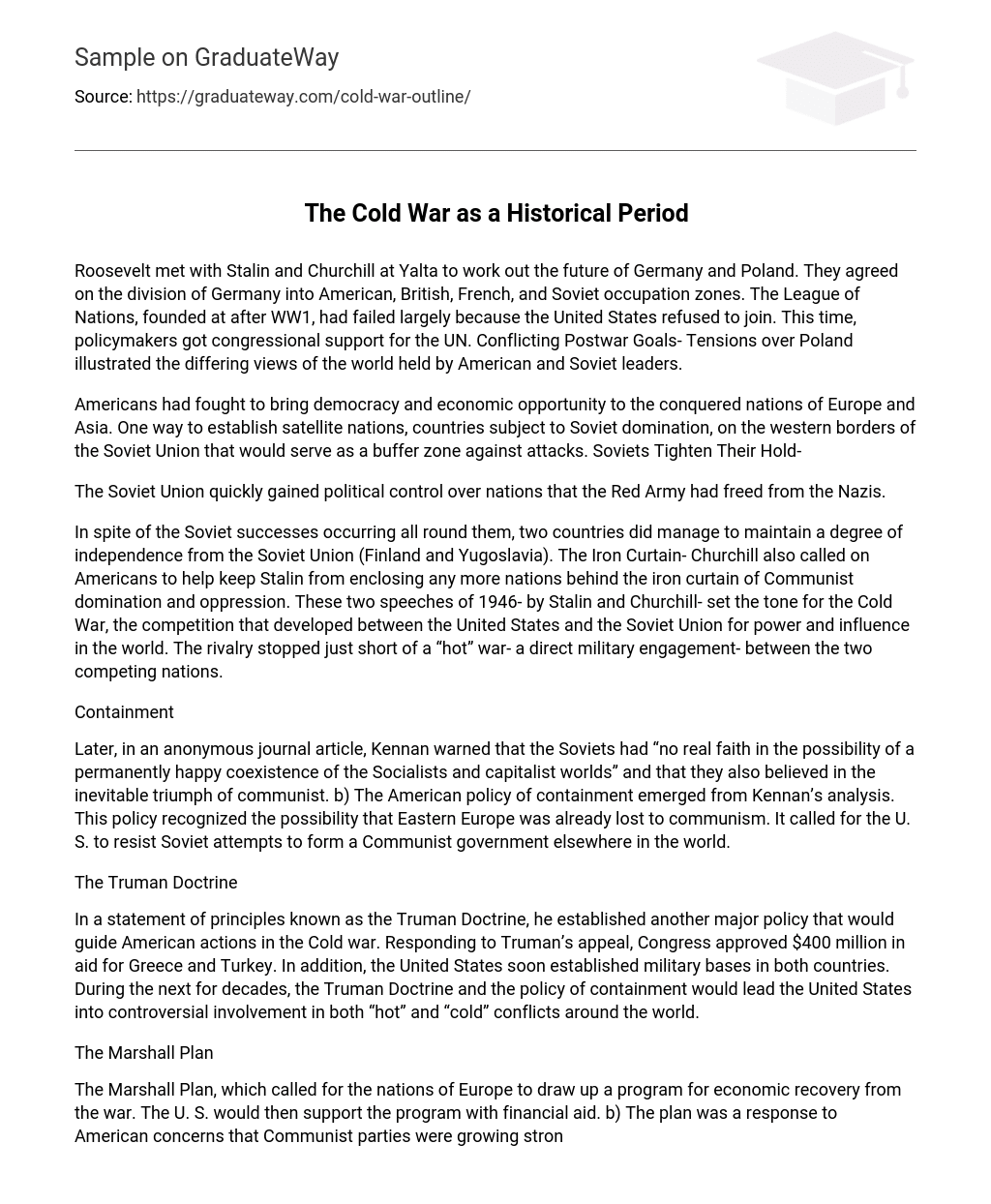Roosevelt met with Stalin and Churchill at Yalta to work out the future of Germany and Poland. They agreed on the division of Germany into American, British, French, and Soviet occupation zones. The League of Nations, founded at after WW1, had failed largely because the United States refused to join. This time, policymakers got congressional support for the UN. Conflicting Postwar Goals- Tensions over Poland illustrated the differing views of the world held by American and Soviet leaders.
Americans had fought to bring democracy and economic opportunity to the conquered nations of Europe and Asia. One way to establish satellite nations, countries subject to Soviet domination, on the western borders of the Soviet Union that would serve as a buffer zone against attacks. Soviets Tighten Their Hold-
The Soviet Union quickly gained political control over nations that the Red Army had freed from the Nazis.
In spite of the Soviet successes occurring all round them, two countries did manage to maintain a degree of independence from the Soviet Union (Finland and Yugoslavia). The Iron Curtain- Churchill also called on Americans to help keep Stalin from enclosing any more nations behind the iron curtain of Communist domination and oppression. These two speeches of 1946- by Stalin and Churchill- set the tone for the Cold War, the competition that developed between the United States and the Soviet Union for power and influence in the world. The rivalry stopped just short of a “hot” war- a direct military engagement- between the two competing nations.
Containment
Later, in an anonymous journal article, Kennan warned that the Soviets had “no real faith in the possibility of a permanently happy coexistence of the Socialists and capitalist worlds” and that they also believed in the inevitable triumph of communist. b) The American policy of containment emerged from Kennan’s analysis. This policy recognized the possibility that Eastern Europe was already lost to communism. It called for the U. S. to resist Soviet attempts to form a Communist government elsewhere in the world.
The Truman Doctrine
In a statement of principles known as the Truman Doctrine, he established another major policy that would guide American actions in the Cold war. Responding to Truman’s appeal, Congress approved $400 million in aid for Greece and Turkey. In addition, the United States soon established military bases in both countries. During the next for decades, the Truman Doctrine and the policy of containment would lead the United States into controversial involvement in both “hot” and “cold” conflicts around the world.
The Marshall Plan
The Marshall Plan, which called for the nations of Europe to draw up a program for economic recovery from the war. The U. S. would then support the program with financial aid. b) The plan was a response to American concerns that Communist parties were growing stronger across Europe, and that the Soviet Union might intervene to support more of these Communist movements.
The Berlin Airlift
The U. S, Britain, and France prepared to merge their three occupational zones to create a new nation, The Federal Republic of Germany, or West Germany. ) Capitalist West Berlin and Communist East Berlin became visible symbols of the developing Cold War struggle between the Soviet Union and the Western Powers.
NATO
In the early postwar period the international community looked to the United Nations to protect nations from invasion or destabilization by foreign governments, and to maintain world peace. In April 1949, Canada and the U. S. joined Belgium, Britain, Denmark, France, Iceland, Italy, Luxembourg, the Netherlands, Norway, and Portugal to form the North Atlantic Treaty Organization (NATO).
Member nations agreed that “an armed attack against one or more of them…shall be considered an attack against them all. ”
Communists Advances
Truman’s response to the Soviet atomic threat was to forge ahead with a new weapon to maintain America’s nuclear superiority. In the early 1950, he gave approval for the development of a hydrogen, or thermonuclear, bomb that would be many time more destructive than the atomic bomb. Many Americans viewed the “loss of China” as a stain on the record of the Truman administration.
Members of Congress and other who held this view called for greater efforts to protect the rest of Asia from communism.
The Cold War at Home
As the Loyalty Review Board carried out its work, Congress pursued its own loyalty programs. The House Un-American Activities Committee (HUAC) had been established in 1938 to investigate disloyalties on the eve of WWII. The HUAC investigations had a powerful impact on filmmaking. Nervous motion picture executives denounced the Hollywood Ten for having done a disservice to their industry. Congress passed the McCarran-Walter Act in 1952 which reaffirmed the quota system for each country that had been established in 1924. It discriminated against potential immigrants from Asia and from Southern and Central Europe.
Communists Expansion in Asia
In the mid 1920s, the Nationalist Party led by Jiang Jieshi gained strength in northern China and captured Beijing. Meanwhile, the Communists had made gains around Shanghai. In 1927, Jiang sent troops to attack the Communists and their supporters.
The result was a massacre that would lead to civil war. The communists were led by Mao Zedong. He gained support for the Communist cause in southern eastern China by redistributing land to the peasant and offering them schooling and health care. Seeking territory and influence in China before WWI, Japan had also annexed the Korean peninsula. Japanese rule of Korea was harsh, and hoped that their nation would be restored after the Japanese were finally defeated in WWII.
The Korean Conflict
The Effects of the Korean War
One change was in military itself. Although President Truman had ordered the integration of the armed forces in 1948, the Korean War was the first war in which White Americans and African Americans served in the same units. At home, the military establishment became more powerful as it developed links to the corporate and scientific communities. These ties created a powerful military-industrial complex.





